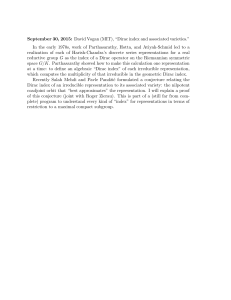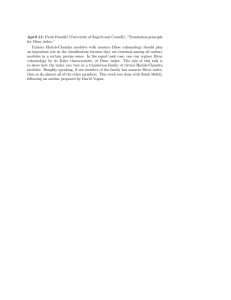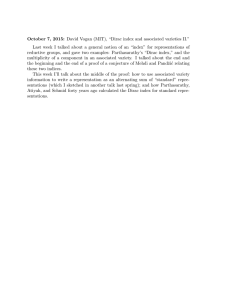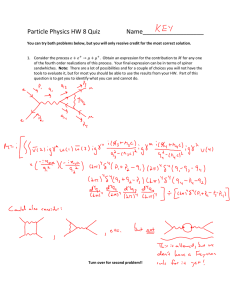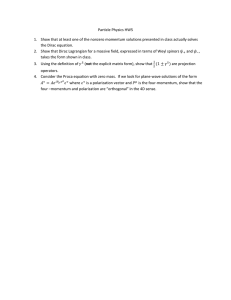Document 13664211
advertisement
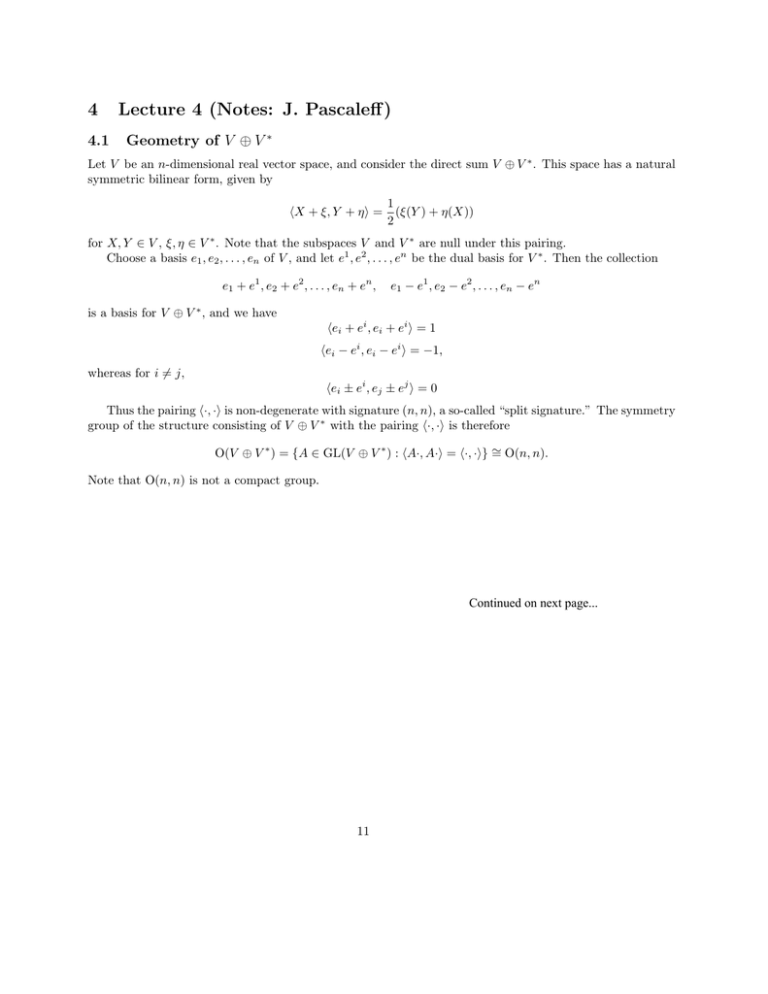
4
4.1
Lecture 4 (Notes: J. Pascaleff )
Geometry of V ⊕ V ∗
Let V be an n-dimensional real vector space, and consider the direct sum V ⊕ V ∗ . This space has a natural
symmetric bilinear form, given by
�X + ξ, Y + η� =
1
(ξ(Y ) + η(X))
2
for X, Y ∈ V , ξ, η ∈ V ∗ . Note that the subspaces V and V ∗ are null under this pairing.
Choose a basis e1 , e2 , . . . , en of V , and let e1 , e2 , . . . , en be the dual basis for V ∗ . Then the collection
e1 + e1 , e2 + e2 , . . . , en + en ,
e1 − e1 , e2 − e2 , . . . , en − en
is a basis for V ⊕ V ∗ , and we have
�ei + ei , ei + ei � = 1
�ei − ei , ei − ei � = −1,
whereas for i �= j,
�ei ± ei , ej ± ej � = 0
Thus the pairing �·, ·� is non-degenerate with signature (n, n), a so-called “split signature.” The symmetry
group of the structure consisting of V ⊕ V ∗ with the pairing �·, ·� is therefore
∼ O(n, n).
O(V ⊕ V ∗ ) = {A ∈ GL(V ⊕ V ∗ ) : �A·, A·� = �·, ·�} =
Note that O(n, n) is not a compact group.
Continued on next page...
11
We have a natural orientation on V ⊕ V ∗ coming from the canonical isomorphisms
det (V ⊕ V ∗ ) = det V ⊗ det V ∗ = R.
The symmetry group of V ⊕ V ∗ therefore naturally reduces to SO(n, n).
The Lie algebra of SO(V ⊕ V∗ ) is
so(V ⊕ V ∗ ) = {Q : �Q·, ·� + �·, Q·�}.
By way of the non-degenerate bilinear form on V ⊕ V ∗ , we may identify V ⊕ V ∗ with its dual, and so we
may write
so(V ⊕ V ∗ ) = {Q : Q + Q∗ = 0}.
We may decompose Q ∈ so(V ⊕ V ∗ ) in view of the splitting V ⊕ V ∗ :
�
�
A β
Q=
,
B D
where
A:V →V
B :V →V∗
β :V∗ →V
D :V∗ →V∗
The condition that Q + Q∗ = 0 means now
Q∗ =
�
D∗
B∗
β∗
A∗
�
= −Q,
or D∗ = −A, β ∗ = −β, and B ∗ = −B. The necessary and sufficient conditions that A, β, B, D give an
element of so(V ⊕ V ∗ ) are therefore
A ∈ EndV,
β ∈ ∧2 V,
B ∈ ∧2 V ∗ ,
D = −A∗ .
Thus we may identify so(V ⊕ V ∗ ) with
End(V ) ⊕ ∧2 V ⊕ ∧2 V ∗ .
This decomposition is consistent with the fact that, for any vector space E with a non-degenerate sym­
metric bilinear form �·, ·�, we have
so(E) = ∧2 E.
In the case of E = V ⊕ V ∗ this gives
so(V ⊕ V ∗ ) = ∧2 (V ⊕ V ∗ ) = ∧2 V ⊕ (V ⊗ V ∗ ) ⊕ ∧2 V ∗ ,
and the term V ⊗ V ∗ is just End(V ).
Of particular note is the fact that the “usual” symmetries End(V ) of V are contained in the symmetries
of V ⊕ V ∗ . (Since V is merely a vector space with no additional structure, its symmetry group is GL(V ),
with Lie algebra gl(V ) = End(V ).)
Now we examine how the different parts of the decomposition
so(V ⊕ V ∗ ) = End(V ) ⊕ ∧2 V ⊕ ∧2 V ∗
act on V ⊕ V ∗ .
Any A ∈ End(V ) corresponds to the element
�
�
A
0
QA =
∈ so(V ⊕ V ∗ ).
0 −A∗
12
Which acts on V ⊕ V ∗ as the linear transformation
� A
�
e
0
eQA =
∈ SO(V ⊕ V ∗ )
0 ((eA )∗ )−1
Since any transformation T ∈ GL+ (V ) of positive determinant is eA for some A ∈ End(V ). We can regard
GL+ (V ) as a subgroup of SO(V ⊕ V ∗ ). In fact the map
�
�
P
0
P �→
0 (P ∗ )−1
gives an injection of GL(V ) into SO(V ⊕ V ∗ ).
Thus, once again, the usual symmetries GL(V ) may be regarded as part of a larger group of symmetries,
namely SO(V ⊕ V ∗ ). This is the direct analog of the same fact at the level of Lie algebras.
Now consider a 2-form B ∈ ∧2 V ∗ . This element corresponds to
�
�
0 0
QB =
∈ so(V ⊕ V ∗ ),
B 0
which acts V ⊕ V ∗ as the linear transformation
�
� �
� �
0 0
1 0
0
eB = eQB = exp
=
+
B 0
0 1
B
�
�
0
1
+0=
0
B
�
0
,
1
since Q2B = 0. More explicitly, eQ
B is the map
� �
�
� �
�
X
X
X
=
.
�→
ξ + iX B
ξ
ξ + B(X)
Thus B gives rise to a shear transformation which preserves the projection onto V . These transformations
are called B-fields.
The case of a bivector β ∈ ∧2 V is analogous to that of a 2-form: β corresponds to
�
�
0 β
Qβ =
0 0
which acts on V ⊕ V ∗ as
β
Qβ
e =e
�
1
=
0
β
1
� � �
�
�
X
X + iξ β
�→
:
,
ξ
ξ
or in other words a shear transformation preserving projection onto V ∗ . These are called β-field transfor­
mations.
In summary, the natural structure of V ⊕ V ∗ is such that we may regard three classes of objects defined
on V , namely, endomorphisms, 2-forms, and bivectors, as orthogonal symmetries of V ⊕ V ∗ .
4.2
Linear Dirac structures
A subspace L ⊂ V ⊕ V ∗ is called isotropic if
�x, y� = 0 for all x, y ∈ L.
If V has dimension n, then the maximal dimension of an isotropic subspace in V ⊕ V ∗ is n. Isotropic
subspaces of the maximal dimension are called linear Dirac structures on V .
Examples of linear Dirac structures on V are
13
1. V
2. V ∗ .
3. eB V = {X + iX B : X ∈ V }, which is simply the graph ΓB of the map B : V → V ∗ .
4. eβ · V ∗ = {iξ β + ξ : ξ ∈ V ∗ }.
5. In general, A · V , where A ∈ O(V ⊕ V ∗ ).
Exercise. If D is a linear Dirac structure on V , such that the projection onto to V , πV (D) = V , then there
is a unique B : V → V ∗ such that D = eB V . Specifically B = πV ∗ ◦ (πV |D)−1 .
A further example of a linear Dirac structure is given as follows: let Δ ⊂ V be any subspace of dimension
d. Then the annihilator of Δ, Ann(Δ), consisting of all 1-forms which vanish on Δ is a subspace of V ∗ of
dimension n − d. The space
D = Δ ⊕ Ann(Δ) ⊂ V ⊕ V ∗
is then isotropic of dimension n, and is hence a linear Dirac structure.
When we apply a B-field to a Dirac structure of this kind, we get
eB (Δ ⊕ Ann(Δ)) = {X + ξ + iX B : X ∈ Δ, ξ ∈ Ann(Δ)}
= eB (Δ) ⊕ Ann(Δ).
We define the type of a Dirac structure D to be codim(πV (D)). The computation above shows that a
B-field transformation cannot change the type of a Dirac structure.
What matters in this computation is not so much B itself as it is the pullback f ∗ B of B under the
inclusion f : Δ → V . Indeed, if f ∗ B = f ∗ B � , then
0 = iX (f ∗ B − f ∗ B � ) = f ∗ (iX B − iX B � ).
This means that iX B − iX B � ∈ Ann(Δ), and so
�
eB (Δ) ⊕ Ann(Δ) = eB (Δ) ⊕ Ann(Δ).
Generalizing this observation, let f : E → V be the inclusion of a subspace E of V , and let � ∈ ∧2 E ∗ .
Then define
L(E, �) = {X + ξ ∈ E ⊕ V ∗ : f ∗ ξ = iX �},
which is a linear Dirac structure. Note that when � = 0,
L(E, 0) = E ⊕ Ann(E).
Otherwise, L(E, �) is a general Dirac structure.
Conversely, the subspace E and 2-form � may be reconstructed from a given Dirac structure L. Set
E = πV (L) ⊂ V.
Then
L ∩ V ∗ = {ξ : �ξ, L� = 0}
= {ξ : ξ(πV (L)) = 0}
= Ann(E).
14
We can define a map from E to V ∗ /L ∩ V ∗ by taking e ∈ E first to (πV |L)−1 (e) ∈ L, and then projecting
onto V ∗ /L ∩ V ∗ ; this yields
� : E → V ∗ /L ∩ V ∗ = V ∗ /Ann(E) = E ∗ .
Then we have � ∈ ∧2 E ∗ , and L = L(E, �).
In an analogous way, we could consider Dirac structures L = L(F, γ), where F = πV ∗ (L), and γ : F → F ∗ .
Exercise. Let Dirk (V ) be the space of Dirac structures of type k. Determine dim Dirk (V ). Compare this to
the usual stratification of the Grassmannian Grk (V ).
A B-field transformation cannot change the type of a Dirac structure, since
eB L(E, �) = L(E, � + f ∗ B).
However, a β-field transform can. Express a given Dirac structure L as L(F, γ), with g : F → V ∗ an
inclusion, and γ ∈ ∧2 F ∗ . Let E = πV (L), which contains L ∩ V = Ann(F ). Thus
E/L ∩ V = E/Ann(F ) = Im γ,
and so
dim E = dim L ∩ V + rank γ.
Since rank γ is always even, if we change γ to γ + g ∗ β, we can change dim E by an even amount.
The space Dir(V ) of Dirac structures has two connected components, one consisting of those of even
type, and one consisting of those of odd type.
4.3
Generalized metrics
There is another way to see the structure of Dir(V ). Let C+ ⊂ V ⊕ V ∗ be a maximal subspace on which
⊥
be the
the pairing �·, ·� is positive definite, e.g., the space spanned by ei + ei , i = 1, . . . , n. Let C− = C+
orthogonal complement. Then �·, ·� is negative definite on C− .
If L is a linear Dirac structure, then L ∩ C± = {0}, since L is isotropic. Thus L defines an isomorphism.
L : C+ → C−
such that −�Lx, Ly� = �x, y�, since �x + Lx, y + Ly� = 0. By choosing isomorphism between C± and Rn
with the standard inner product, any L ∈ Dir(V ) may be regarded as an orthogonal transformation of Rn ,
and conversely. Thus Dir(V ) is isomorphic to O(n) as a space. The two connected components of O(n)
correspond in some way to the two components of Dir(V ) consisting of Dirac structures of even and odd
type.
Observe that because C+ is transverse to V and V ∗ , the choice of C+ is equivalent to the choice of a map
γ : V → V ∗ such that the graph Γγ is a positive definite subspace, i.e., for 0 �= x ∈ V ,
�x + γ(x), x + γ(x)� = γ(x, x) > 0.
Thus if we decompose γ into g + b, where g is the symmetric and b the anitsymmetric part, then g must be
a positive definite metric on V . The form g + b is called a generalized metric on V . A generalized metric
defines a positive definite metric on V ⊕ V ∗ , given by
�·, ·�|C+ − �·, ·�|C−
Exercise. Given A ∈ O(n), determine explicitly the Dirac structure LA determined by the map O(n) →
Dir(V ).
15

